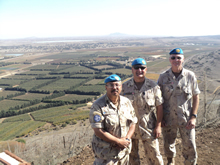Operation GLADIUS
Operation GLADIUS was part of Canada’s participation in the United Nations Disengagement Observer Force (UNDOF) on the Golan Heights between Israel and Syria.
Task Force Golan Heights
Task Force Golan Heights consisted of three Canadian Armed Forces officers who served in the following appointments:
- Military Assistant to the UNDOF Commander;
- Senior Staff Officer Personnel at UNDOF Headquarters, located at Camp Faouar; and
- Liaison Officer to the Senior Syrian Arab Delegate.
Mission context
The conflict
On 6 October 1973, Israel was attacked by its neighbours on two fronts: by Egypt on the Suez Canal and in the Sinai Peninsula, and by Syria on the Golan Heights. Known variously as the October War, the Ramadan War and the Yom Kippur War, the ensuing conflict lasted 19 days, despite diplomatic and military interventions by the United States and the Soviet Union, and a ceasefire ordered by the United Nations Security Council Resolution 338 on 23 October 1973.
On 25 October 1973, after ordering a second ceasefire with Resolution 339, the U.N. Security Council authorized the transfer of contingents from the United Nations Force in Cyprus to the Suez Canal zone to separate the Israeli and Egyptian forces deployed there, and thus bring a halt to hostilities on the southern front.
On the northern front, where an Israeli counter-attack had achieved a deep incursion into Syrian territory, the ceasefire in the south produced a hostile stalemate on the Golan Heights. Left without allies, the President of Syria cancelled a counter-offensive designed to repulse the Israeli invasion and ordered a ceasefire, while the Israelis held their positions. Months of skirmishing, artillery exchanges and air battles followed, culminating in the spring of 1974 with a failed Syrian attempt to recapture the summit of Mount Hermon, the highest point on the Golan Heights.
The Agreement on Disengagement
In March 1974, as the situation deteriorated on the Golan Heights, the United States resumed vigorous diplomatic efforts backed by the U.N. Security Council. Finally, on 31 May 1974, representatives of Israel and Syria signed the Agreement on Disengagement, and the U.N. Security Council adopted Resolution 350 to approve it and authorize the deployment of forces to monitor compliance.
The Agreement on Disengagement established the Area of Separation on the Golan Heights between the positions held by Syrian and Israeli forces on 25 October 1973. The Area of Separation is more than 75 km long and varies in width from about 10 km in the centre to 200 meters in the extreme south. Military forces are not permitted to enter it, and only residents may come and go freely within it. Each side of the Area of Separation is further buffered by an Area of Limitation, where the movement of belligerent forces is permitted under strictly controlled circumstances.
UNDOF origins and mandate
U.N. Security Council Resolution 350 of 31 May 1974 approved the Agreement on Disengagement and authorized the formation of the United Nations Disengagement Observer Force — UNDOF — with up to 1,250 military personnel and a mandate to:
- Maintain the ceasefire between Israel and Syria;
- Supervise the disengagement of Israeli and Syrian forces; and
- Supervise the areas of separation and limitation as provided in the Agreement on Disengagement.
Since its formation, UNDOF has had its mandate renewed every six months.
Canada and UNDOF
Canada’s involvement with UNDOF began with the launch of Operation DANACA in June 1974, which provided Canadian Forces logistics and signals units to support the entire mission.
Originally comprising more than 200 personnel, Operation DANACA was scaled back to 186 in 1992 and 1993, when UNDOF was reduced in size. By March 2006, when Operation DANACA closed, some 12,000 Canadian soldiers, sailors and air personnel had served on the Golan Heights.
The initial rotation of Operation GLADIUS consisted of four officers who remained in staff positions with UNDOF when the logistics unit deployed under Operation DANACA returned to Canada. The task force was reduced to two in July 2006, and increased to three in 2011.
Links
Government of Canada
- Canada and the Middle East Peace Process (Foreign Affairs, Trade and Development Canada)
International missions
- United Nations Disengagement Observer Force (U.N. site)
- United Nations Emergency Force I (U.N. site)
- United Nations Emergency Force II (U.N. site)
- United Nations Truce Supervision Organization (U.N. site)
Pertinent documents
- United Nations Security Council Resolution 338 (1973) 22 October 1973
- United Nations Security Council Resolution 339 (1973) 23 October 1973
- United Nations Security Council Resolution 340 (1973) 25 October 1973
- United Nations Security Council Resolution 350 (1974) 31 May 1974
- Israel-Syria: Agreement on Disengagement 31 May 1974
- United Nations Security Council Resolution 2108 (2013) 27 June 2013
